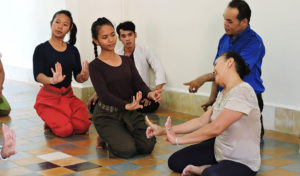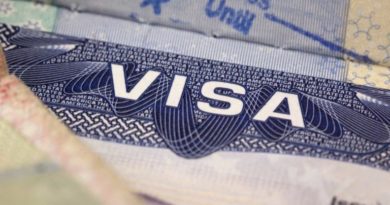PHNOM PENH: ARTS -The return of Cambodia’s ‘last Apsara’
.
.
In 1973, Colin Grafton photographed one of the last classical dance performances held in Phnom Penh before the Khmer Rouge arrived and has held exhibitions of those photos. It took many years, but he finally tracked them down, including the lead dancer, Voan Savay.
She moves with the grace of a woman 20 years younger. She has a sharp and mischievous wit. She is warm and generous, and self-possessed.
She says what she thinks and she knows what she wants. When she smiles, her teeth flash. If she’s teaching you, you’d better show results.
Although she looks like an auntie, she’s still a prima donna and her students are in awe of her. She is teaching them Khmer classical dance in a bare room on the ground floor of one of the outer buildings of Sisowath High School.
The students are of all ages. She teaches both male and female roles. She can be an Apsara or an ogre.
In 1971, Voan Savay was the star Apsara dancer with the Khmer Royal Ballet troupe when they went on tour to the US. In Washington, a company called Camera Three made a documentary about “the last embodiment of classical dance in Cambodia in one of their last performances”.
According to the narrator, the Royal Ballet had been “systematically destroyed by successive governments in the last decade, and the very existence of this art was threatened”. Now, he continued, it was finished and the surviving dancers were dispersed, living in exile all over the world.
.

.
Savay performed the Apsara dance and was interviewed. She said she was 18 years old. In fact she was 20, but she decided to lie about her age to create the impression she desired.
Camera Three’s portents of doom were premature. In 1973, I saw Savay performing the Apsara Dance in the National Theatre of Phnom Penh, together with a troupe of “exiled” dancers, and I took photos of her on stage.
In April 1975 the Khmer Rouge took Phnom Penh and Savay left the city with the rest of the population. She worked in the countryside for the duration of the regime. She kept her mouth shut, did what she was told, and was determined to survive.
She told no one she was a dancer.
When the Pol Pot regime fell in 1979, she went back to Phnom Penh and married another dancer.
After a year they decided to leave Cambodia and made their way to Nong Chan refugee camp, on the Thai border.
Savay saw many children there and she decided to stay and teach them to dance. For the next few years she moved around the border area organising dance classes in various camps.
Politics did not matter to her. She was a dancer and a teacher, that was all. However, she could not bring herself to stay in Site 8, controlled by the Khmer Rouge, but arranged for students from there to come to her for instruction.
After Nong Chan was attacked and destroyed, the population moved to Site 2, which became a refugee city of 145,000 inhabitants. Savay set up a dance school in the Cultural Centre.
Her dancers were superb and they performed all over Thailand.
In 1991, after almost 10 years in the camps, Savay took a large group, including dancers, musicians and costumiers, on a three-month tour of the United States.
Later that year she finally returned to Cambodia and she and her troupe joined the Ministry of Culture and Fine Arts. Since 1997, she has spent much time in France, travelling to teach dance in Canada and the US, and visiting Cambodia regularly.
However, she was not in Cambodia when she was identified as the dancer in my Apsara photo exhibition, so I could not meet her.
In July 2017, I met Phou Jean-Baptiste, the Cambodia Living Arts Country Manager. He had recently come from Paris and I noticed from his movement that he was probably a dancer, so I asked him if he knew Voan Savay.
He said he did, that he was studying with her, and that she was now in Cambodia, teaching dance classes at the Sisowath High School every Sunday. She was the only living dancer in the photos that I had not met. I knew her history, but I had been waiting more than a year to actually meet her in person.
Watching Voan Savay teach is a fascinating experience. Despite her age, she still has perfect balance and control and she teaches like a kung-fu master, no nonsense and a stick.
.

She teaches all day and she never looks tired. “I am 67, and my body is getting old,” she said to me in French.
“But I have to continue to teach as much and as many as I can, while I still have this energy.”
She gave me the Savay look, which is straight in the eye. “Je suis pressé (I am in a hurry),” she said.
Her sense of urgency is palpable and ever-present. There is also a touch of desperation. She accepts anyone who shows the required ability and dedication to dance. Money is not important.
She feels that there is too much self-interest, too much ego in the dance world.
She came to Battambang for the opening of my “Dancers” exhibition, featuring photos I took in Phnom Penh in 1973.
The idea was to give a one-day crash course to two dancers from the Phare Ponleu Selapak dance group in the disciplines of the classical dance as performed 100 years ago, before the refinements introduced by Queen Kossomak in the ’50s.
For the opening, the Phare dancers arrived in full “ancient” costume, white-faced and ready to dance. But Savay would have none of this. They were not dressed well enough, and had to be resewn into their garments before they could perform.
It was hot in the improvised dressing room and the audience was already waiting, but that just couldn’t be helped. There are no short cuts for Voan Savay.
All was done the way it must be done, and when they finally got to dance, they danced well.
.

.
Savay also brought Sok Nalys, a principal dancer specialising in the older tradition. When Nalys dances, the contrast is astonishing. Arm movements are wider, sweeping, the body movements more vertical, with much more bending of the knees and sharply angled wrist and fingers.
These are the stances we see in stone on the bas-reliefs of Angkor Wat, the apsaras who float above the sea of milk.
Ironically, the Apsara Dance created by Queen Kossomak ironed out these movements into something more elegant but earthbound.
Halfway through Nalys’ dance performance, the recorded music abruptly failed, but she did not miss a beat, continuing the flowing, almost bouncing movements in silence.
Then she began to sing herself. Savay and the Phare dancers backstage quickly picked up the melody and brought the dance to its conclusion.
Savay seemed pleased. Back in the hotel lobby she and Nalys clicked into a discussion on correct technique, bending their wrists and fingers into almost impossible positions, oblivious to the curiosity of the hotel staff, who did not realise they were in the presence of a real Apsara.
A joint exhibition of these and other photos taken by Colin Grafton and Alessandro Marazzi Sassoon on the theme of “Dancing Through Time” will open at Meta House Lower Gallery on Thursday, January 11.
COURTESY:
Khmer Times
December 22, 2017
.
NOTE : All photographs, news, editorials, opinions, information, data, others have been taken from the Internet ..aseanews.net | [email protected] |
For comments, Email to :
Zhubiz Chezmiz | [email protected] | – Contributor










